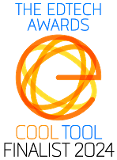Investigating Digital Citizenship
![]()

Students learn about their rights and responsibilities as digital citizens through dynamic activities.
Core concepts include digital safety, ethics, communication, and literacy.
The comic book, The STEM Sagas Virtually Rerouted, brings the challenge concepts to life while supporting the idea of collaborative problem-solving with a cast of diverse characters and exciting adventure.
Lesson Plan Overview: suggested 10 lessons over 20 days
Lesson 1: Introducing Digital Citizenship (60-90 Minutes)
Students are introduced to the topic of digital citizenship and why it is important. Students are also introduced to the characters and the story that carries through the remaining lessons. Set on stage at a school drama production, the characters must decipher clues, solve puzzles, and answer questions related to digital citizenship as they journey together to help a friend in need.
Lesson 2: Projecting Your Digital Tattoo (75-125 Minutes)
Students consider how assumptions can be made, and future opportunities can by impacted by a digital tattoo. They conduct their own online investigation of students whose lives have been impacted by their digital decisions.
Lesson 3: Engaging in Online Communication (65-85 Minutes)
Students reflect on the differences between formal and informal digital communication and consider the appropriate style and tone for particular audiences. They learn about engaging respectfully in online conversations and how to be empathetic communicators.
Lesson 4: Investigating Content Ownership (45-60 minutes)
Students define copyright, trademark, public domain, and fair use. Then, they consider different scenarios and determine what types of work are protected by copyright law and what may qualify as fair use. They also learn the importance of giving credit when sharing other people’s work.
Lesson 5: Exploring Content Collection (60-90 minutes)
Students learn about the types of data collected from apps and websites, why those sites collect the data, and how they use the data. Students consider how algorithms on apps and websites can affect their online experience.
Lesson 6: Examining the Importance of Data Privacy (45-60 minutes)
Students consider the importance of digital privacy and the value of reviewing privacy policies. They identify ways to protect their privacy and control the amount and type of data collected from them online.
Lesson 7: Protecting Personal Privacy (45-60 minutes)
Students learn about the “invisible audience” online and discuss ways to adjust privacy settings in social media accounts to better control who can see their content. They consider how f what they choose to share online impacts their own digital tattoo.
Lesson 8: Dealing With Digital Drama (45-70 minutes)
Students discuss reasons drama can escalate quickly in a digital space and identify ways to prevent, avoid, or de-escalate digital drama. They differentiate digital drama from cyberbullying and learn ways to cope and build resilience using mindfulness.
Lesson 9: Defining My Authentic Digital Character (45-60 minutes)
Students consider what it means to be authentic online and discuss how and why people alter their personas in different settings or for different audiences. They identify ways their online usage affects their own well-being and discuss how to respect others’ self-expression.
Lesson 10: Managing Digital Distractions (50-70 minutes)
Students reflect on ways that digital media and devices add distraction to their lives and consider the negative impacts of a distracted mind. They list strategies to limit and manage distractions and increase focus and productivity.
Final Challenge (Three to five 30-minute class periods)
For the culminating activity, students are asked to identify a solution to educate peers on the importance of being a good digital citizen. Students must recall the lessons learned throughout the challenge and create an engaging way to educate their peers on the importance of digital citizenship. Students must create a product or digital content as well as a marketing plan for their creation. They can create content such as a podcast or vlog, a scripted play or television episode, or a book, magazine, or newspaper article. They can market the content through distribution methods such as website ads, an email campaign, social media ads, or influencer promotions. Students are given the freedom to create their product and marketing plan independently.
Kit Materials
This kit provides resources for an average class size of 32 students working in teams of four.
|
Kit Items |
Quantity |
|
Student AWIM Notebooks |
32 |
|
Digital Student Activities |
10 |
|
Online Portal Account with Curriculum and Digital Resources |
1 |





